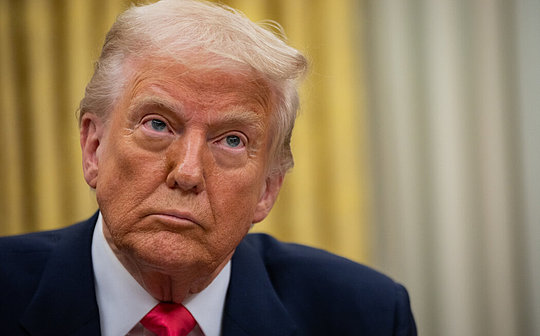
I. President's Statement Sends Positive Signal, Dawn of Hope for Shutdown Deadlock
On January 18th local time, U.S. President Trump made his latest statement regarding the ongoing partial federal government shutdown. Speaking to the media at the White House, Trump's tone was noticeably softer than in previous remarks. He stated, "Based on the current situation, we are very close to ending the government shutdown." This statement was interpreted by Washington circles as a positive signal from the White House for negotiations, indicating a potential key turning point in the budget impasse that has lasted for over ten days.
This statement came just before the Senate was set to vote on a budget bill, suggesting that Republicans may have reached a preliminary consensus internally on breaking the political deadlock. Analysts point out that Trump's choice to express optimism at this moment aims both to stabilize financial markets anxious about the shutdown and to create a more relaxed atmosphere for subsequent bipartisan negotiations.
II. Legislative Process Enters Critical Phase, Omnibus Bill Becomes Core Solution
According to the latest information from Capitol Hill, the U.S. Senate is expected to hold a procedural vote that evening on a temporary funding bill already passed by the House. Notably, the version submitted for review will employ a "legislative bundling" strategy – integrating the originally proposed short-term funding measure with three full-year appropriations bills.
This special legislative design reflects the intricacies of bipartisan political maneuvering:
-
The short-term funding measure would provide continued funding for federal government operations until January 2026, offering a clear timeline for various agencies to resume normal operations.
-
The three full-year appropriations bills cover the annual budgets for key departments, including Veterans Affairs, Transportation, and Housing and Urban Development.
This combined approach of "short-term emergency measure + long-term planning" aims to satisfy both the Republican basic demand to reopen the government quickly and the Democratic insistence on comprehensive budget reform.
III. Bipartisan Support Emerges, Probability of Legislative Passage Increases Significantly
According to Bloomberg News citing Senate insiders, the revised funding plan has now secured sufficient support from Democratic Senators and is expected to meet the required 60-vote threshold for passage in the Senate. This emerging bipartisan support stems mainly from:
-
800,000 federal employees being forced to work without pay or furloughed.
-
Operational disruptions in multiple critical public service departments.
-
Both parties facing significant pressure from their constituents.
Senate Majority Leader, Republican John Thune, confirmed this progress at a press conference but emphasized the complexity of the legislative process: "Even if the Senate passes the amendment, the new funding bill must be sent back to the House for a revote. After House passage, the final text still requires the President's signature to become law. This complete legislative process may take several days to finalize."
IV. Subsequent Procedures Hold Uncertainties, Final Enactment Requires Clearing 'Three Hurdles'
Despite the glimmer of hope, the final enactment of this funding bill still requires clearing three critical steps:
-
First Hurdle: Senate Vote
The evening Senate vote will test the actual support level for the plan among Senators from both parties. Any procedural motion or amendment could alter the legislative process. -
Second Hurdle: House Deliberation
As the bill's content has been significantly modified, the House must hold a revote on the amended version. Given the party distribution in the House, support from Democratic representatives will be the decisive factor. -
Third Hurdle: Presidential Signature
As the final step in the legislative process, the White House's stance is crucial. Although Trump has sent positive signals, his final decision could still be influenced by conservative lawmakers and cabinet members.
V. Underlying Logic Behind the Political Maneuvering
The trajectory of this budget crisis reflects several characteristics of the U.S. political system:
-
Checks and balances between the legislative and executive branches under a divided government.
-
Fundamental disagreements between the two parties on fiscal policy.
-
Cross-party negotiation mechanisms during emergencies.
-
The forcing effect of public opinion on political decision-making.
Observers note that regardless of whether the final plan passes as scheduled, this budget battle will provide an important case study for understanding U.S. political operations. With less than two years until the 2026 election, both parties are carefully weighing political gains and losses, needing to demonstrate sincerity in solving the problem while maintaining consistency in their core policy positions.
Conclusion
As the legislative process enters a critical stage, the government shutdown crisis that has plagued the U.S. seems to be approaching a turning point. However, as Senate Leader Thune reminded, it will still take time from the completion of the procedures to the actual restoration of normal operations. This budget tug-of-war not only tests the wisdom of Washington politicians but also affects millions of ordinary citizens who rely on government services. Developments in the coming days will determine whether the U.S. can truly emerge from this political impasse.
















